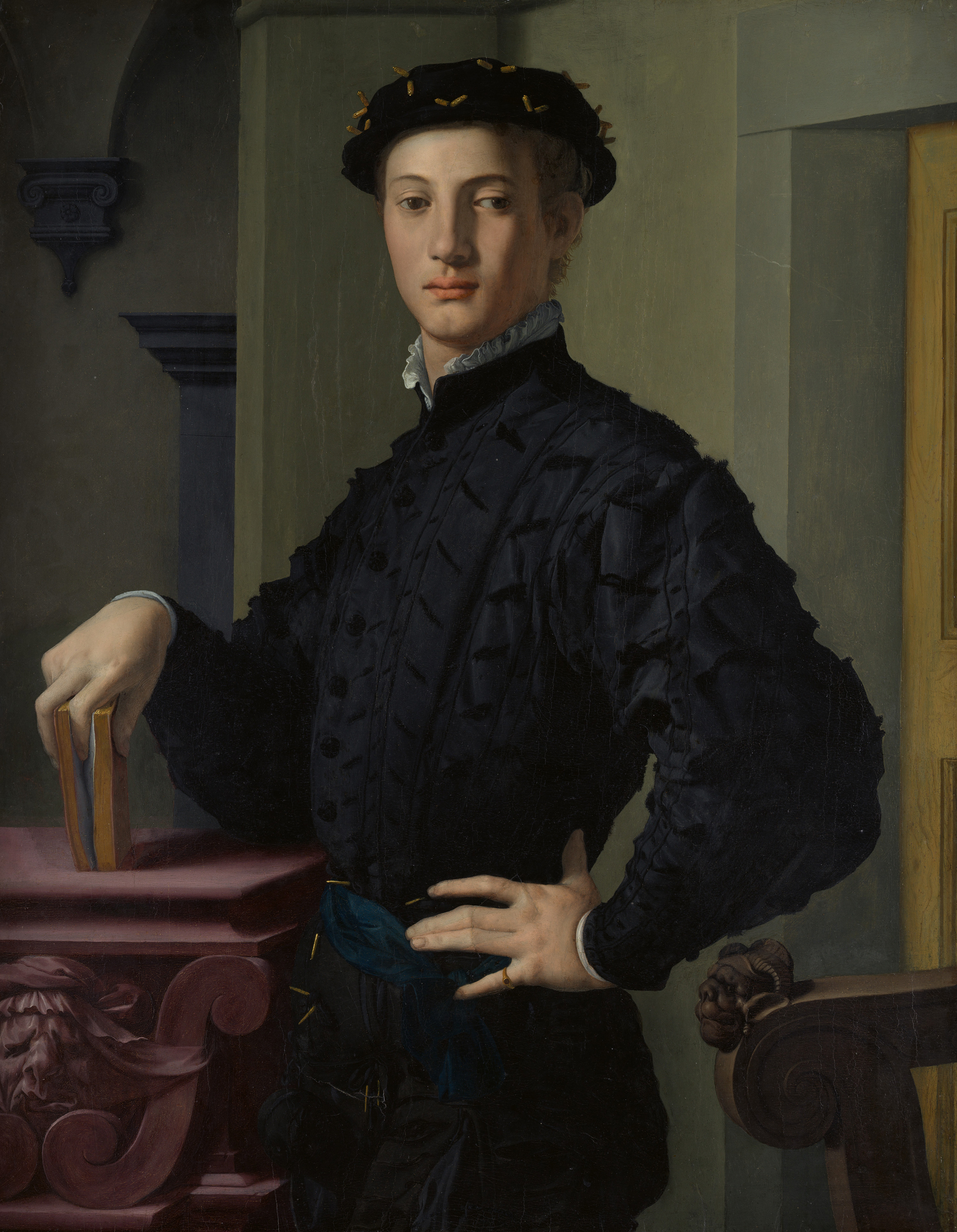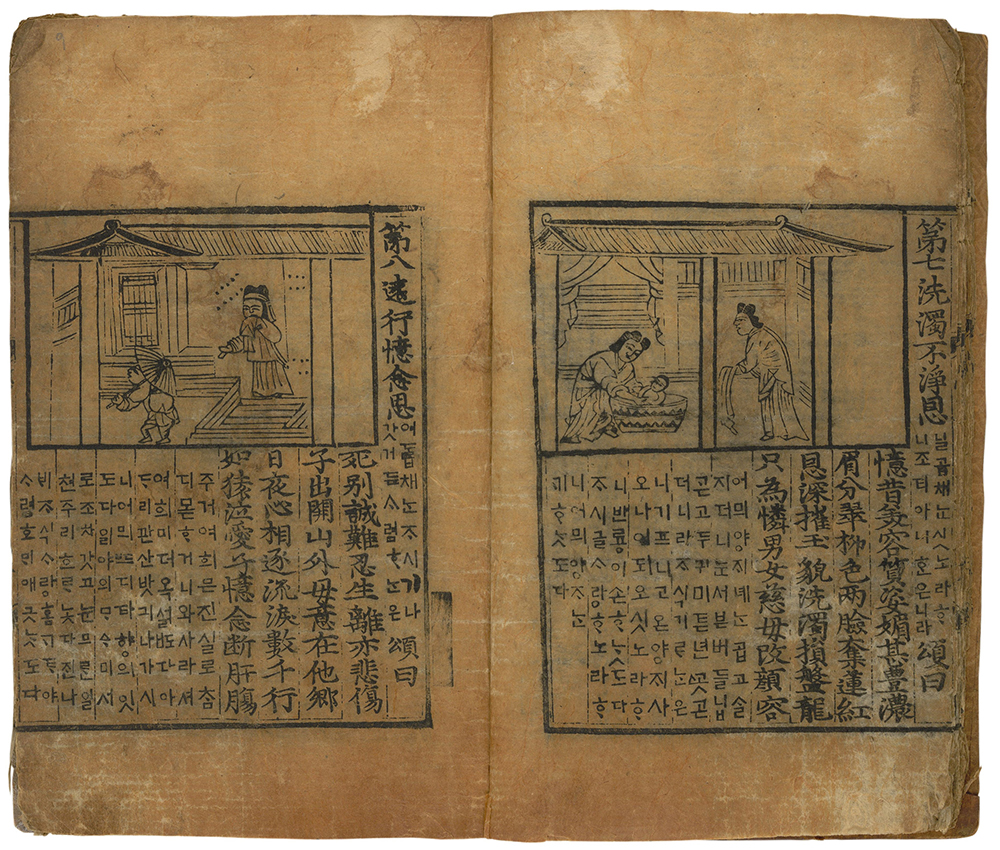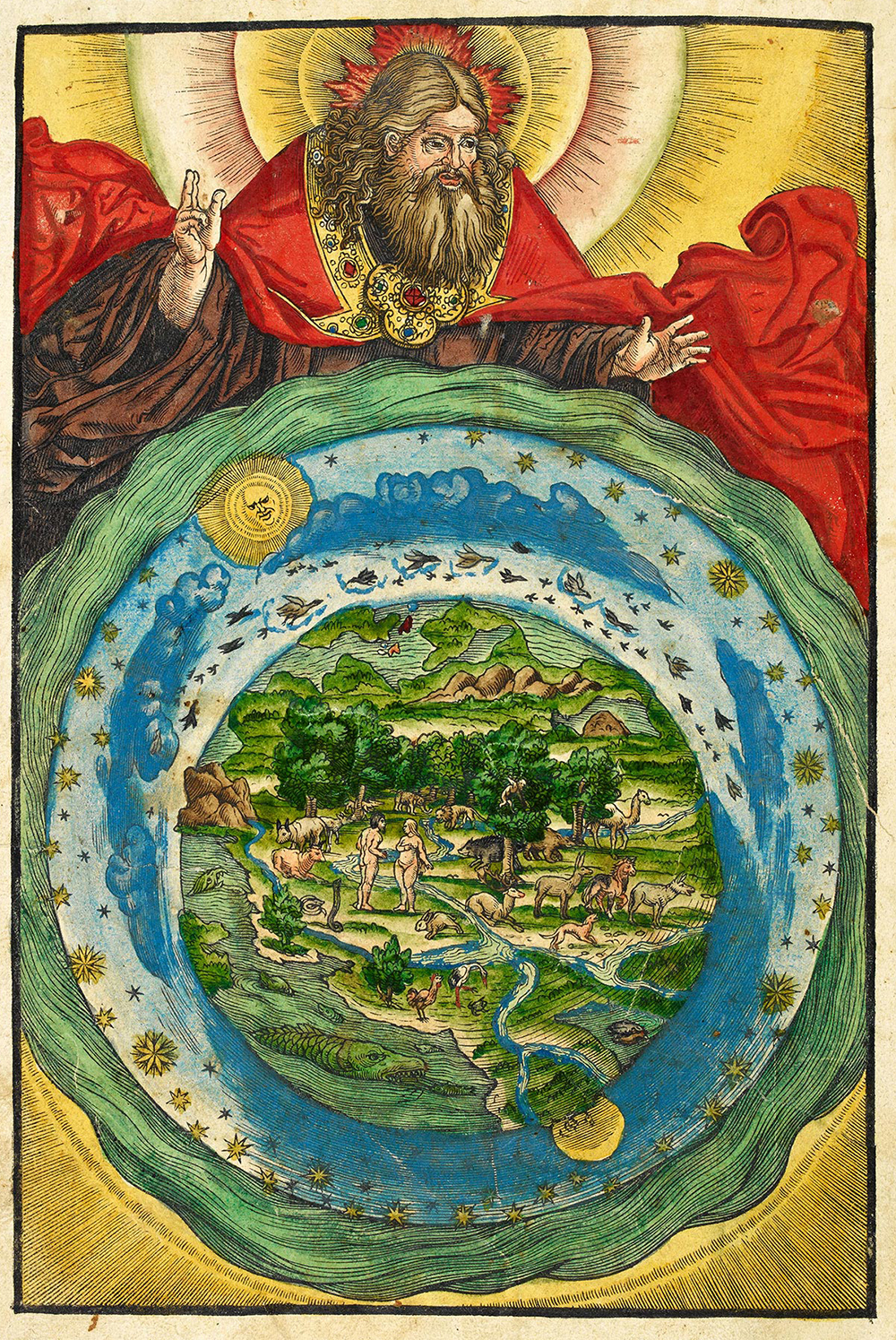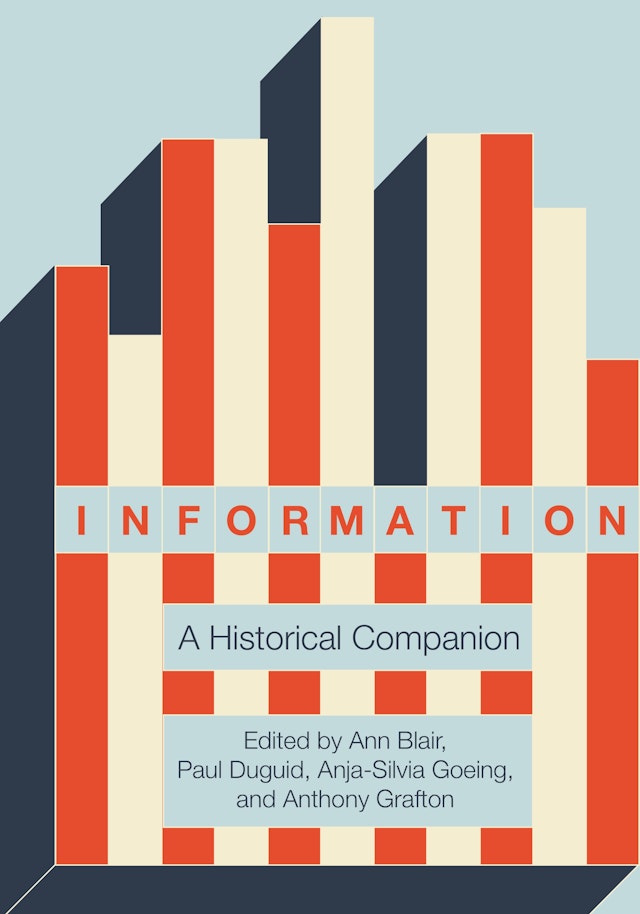
Portrait of a Young Man, by Bronzino, c. 1530. The Metropolitan Museum of Art, H.O. Havemeyer Collection, bequest of Mrs. H. O. Havemeyer, 1929.
It is impossible to measure the odds of someone else inventing printing if Gutenberg had not, but I suggest that they were high. Claims of a simultaneous invention by Laurens Janszoon Coster seem grounded only in a sixteenth-century attempt at burnishing the reputation of Coster’s hometown of Haarlem, in the Netherlands. But all the elements were readily available, as well as existing demand for what printing could offer, so the idea could plausibly have occurred to someone else around the same time. We now appreciate that printing by both woodblock (xylography) and (more rarely) movable characters (made of wood or porcelain but also metal) was in use centuries earlier in multiple East Asian contexts. Nevertheless, there is no good evidence of a westward transmission of printing from Asia to Europe, although gunpowder and papermaking clearly were transmitted in that way.
While East Asian xylography offered the advantages of print on demand (provided the blocks were stored in good condition, which might entail significant expense), European typography was always a more speculative and risky undertaking, involving high expenditures up front and no way to profit from strong sales beyond the copies that had already been planned without incurring most of the production costs again. For example, Gutenberg raised the number of forty-two-line Bibles he produced partway through that first edition, evidently for fear of missing out on the opportunities for profits that those extra copies could offer. It meant resetting the pages that had already been printed at the point when he decided to raise the size of the print run; the small differences between the two settings of type on these pages provide the evidence for this decision.

In Europe printing was a commercial and capitalist venture from the start. Printers who lacked the necessary funds partnered with publishers who provided the capital. For example, Gutenberg could not repay the loan taken out to cover his initial expenses and lost his business to his creditor Johann Fust. Variations of that pattern would be repeated many times over, in the initial explosion of interest in the new business and even once the industry had matured. In Italy printers set up in eighty different towns and cities in the fifteenth century; the resulting overproduction led the vast majority of them to fail.
The risks inherent in the business could be offset by job printing—the production of small items that would sell quickly (e.g., pamphlets with exciting claims or news) or that were paid for in advance by church or government. Some genres were steady sellers and reliable sources of revenue, thanks to strong buyer demand—notably devotional, liturgical, and pedagogical books. More generally, whenever the same printer published a second edition of a work we can presume the first one had sold well. A wise printer would plan a mix of projects, so that risky ones could be covered by safer ones.

In setting up printing presses in various colonies, Europeans valued them as tools to achieve their various goals of converting indigenous populations, creating cohesion among the colonists, or representing imperial power, even though they were not very successful commercially. In Mexico the Seville printer Juan Cromberger produced his first books in 1540, with the support of the bishop there, but probably profited more from his monopoly on importing books than from the one on printing them, both granted to him by Spanish royal decree. Printing started in Goa on the west coast of India in 1556 thanks to a press transported from Portugal by the Jesuits. The first press in the British colonies in America was brought over in 1639 to aid the population of one thousand colonists in Boston and the college they had just founded three years before. The production from these presses was not very great but was symbolically important. Conversely, printing was forbidden in places where the authorities feared it would foster further resistance, for instance, in the Latin-occupied Greek Levant (such as Crete), where the Roman Church hoped to spread its control in the wake of the fall of Byzantium and banned printing lest it be used to shore up Orthodox Christianity instead. Cracow and Prague were the largest printing centers in eastern Europe, producing books in a range of languages and scripts. The first incunabula and Bible printed in Cyrillic type were published there in 1490–1491 and 1517, respectively, as well as many Hebrew imprints for the Jewish communities of Ashkenaz. More generally, European printers needed to cultivate favorable relations with the government under which they operated.
Unlike East Asian xylography, which could be practiced almost anywhere without leaving a trace, typography required considerable capital and could not easily be carried out in secret—the press and metal type were so heavy that some print-shop floors collapsed under their weight. Portable presses were devised and used clandestinely in special circumstances, as in the production of the Marprelate pamphlets in England in 1588–89, but in most cases the new industry operated in full view of its urban environment and subject to regulations of two kinds: commercial and ideological. Printers themselves set up commercial regulations to protect their ability to recover the great expense of publishing a book by preventing others from printing the same work. On the continent printers would seek a privilege that granted them a monopoly on printing a work for a certain number of years, free from competition within the jurisdiction of the grantor. Privileges issued by monarchs or the pope or the emperor were never automatic—they required the favor of the grantor (which could prove difficult to obtain) and the payment of a fee. In England the Stationers’ Company, founded in 1557, operated like a guild and issued licenses to print specific works or kinds of works to members who bid for them. The trade relations that printers and publishers maintained across jurisdictional boundaries also served to regulate behavior; although piracy (which undercut a printer’s market) was a real threat, the fact that printers could retaliate against one another and controlled a powerful medium in which to voice their complaints worked against rampant piracy.
The second form of regulation came from outside the industry, as churches and states sought to control the content that was printed. Censorship did not originate with printing. Producers of texts both oral and written (including preachers, teachers, authors, and scribes) had long since been held responsible for content deemed heretical or seditious. The medieval church issued general condemnations of certain positions and persecuted individuals who seemed to espouse them, especially once heresy became a major concern in the thirteenth century.
Self-censorship of speech and writing was a natural by-product of the efforts to enforce religious, political, and social norms that were widespread across most medieval and early modern contexts. Printing introduced new players in the production of written texts, and printers were soon required to include their name on all their imprints, so they too could be held responsible; one evasive maneuver was to list a false printer’s name and address. Prepublication censorship was common in both Catholic and Protestant contexts, whereby printers had texts approved by the authorities before investing in publishing them, in order to spare themselves the risks of their stock being destroyed or their persons punished. The Catholic Church was unique in forming (in 1559, as part of the Counter-Reformation) a bureaucratic wing of the papacy devoted to postpublication censorship. The Index of Prohibited Books published lists of banned authors and texts, and of specific passages in otherwise allowable texts that Catholics should refrain from reading as dangerous to their faith. Of course a large area of Europe had become Protestant by this point and produced these “bad” books in abundance, beyond the sway of Rome. Depending on their location, Catholics could access more or less easily such books through the market, and some—especially experts, such as medical men seeking to keep up with the latest publications—even did so with permission, which the church granted to trusted individuals. Protestant contexts also exercised postpublication censorship.
In Tudor and Stuart England, for example, royal authorities removed from circulation books they judged offensive and sometimes staged public burnings of them, occasionally accompanied by the corporal punishment of their authors or distributors. Public book burnings, complete with many symbolic elements, were designed to display the power of the state or the condemnation of rebels against authority, but that power did not extend to the contemporary reaction, which could include voices of sympathy for those condemned.

Publishing new ideas could be risky but also supremely successful. The German reformer Martin Luther was especially adept at marshaling the power of the press. His printers at Wittenberg and elsewhere ended up benefiting handsomely from the brisk sales of his works starting with the ninety-five theses of 1517; the books helped to bring about a religious schism that protected their makers from Catholic repression. In other cases, when new ideas did not catch on, printers could pay a heavy price for advancing a cause in which they believed or on which they had wagered; the Lyon printer Etienne Dolet, for example, was executed for heresy in 1546. Authors could hope to keep their identity secret, and some succeeded in doing so; thanks to elaborate ruses, Jonathan Swift avoided being identified as the author of texts that would have been grounds for conviction of libel. But printers had more limited options—a false imprint was the most common evasive maneuver and not always successful, as the authorities could identify printers by the characteristics of their work much as bibliographers do today. As a result, manuscript remained the medium of choice for the distribution of texts that risked legal proceedings against their makers as intolerable on religious, political, or moral grounds. Identifying the culprits was more difficult, and the authorities generally cared less about what circulated in manuscript once printed books were available to cause greater damage.
Printing generated quantities of texts on an unprecedented scale: at least 27,000 editions of incunabula were printed by 1500, followed by more than 320,000 editions in the sixteenth century. The number of printed books that resulted (likely more than three hundred million, excluding the many ephemera that have been completely lost) dwarfed not only the estimated number of European manuscripts surviving from the sixth to the sixteenth century (1.3 million) but also the number of manuscripts estimated to have been available in 1500 (six to seven million).
Complaints about too many books predate printing, including the biblical lament “of making many books there is no end” (Ecclesiastes 12:12) or the thirteenth-century prologue in which Vincent of Beauvais complained of “the multitude of books, the shortness of time, and the slipperiness of memory” that motivated him to write a compendium of all knowledge. While only a narrow elite of scholars had experienced it in earlier periods, after the first century of printing a broad cross section of the educated articulated a concern about what we would call “information overload”—the sense that there were too many books for an individual to read and to master. Complaints about an overabundance of books became a well-worn refrain throughout early modern Europe and were used to justify any number of postures: railing about the base commercial motives of printers who produced whatever sold without a care for quality or intellectual merit, mocking the vanity of bookish learning, worrying about the end of civilization from too many people writing (bad) books and no one reading good ones anymore, or on the contrary worrying that authors with new ideas would be discouraged from writing by the mass of what already existed.
These complaints about the consequences of printing were of course made in printed books, which added to the abundance of which they complained while offering various remedies to the overload: advice on how to read well, for example by taking good notes; judgments and reviews of books to aid in selecting them (a prime content of learned periodicals starting in the late seventeenth century); bibliographies to identify existing books (and possibly to deter the unnecessary composition of new ones); and reference works designed to collect the best parts of the best books to spare readers the trouble and expense of making these selections themselves. Printing prompted a new awareness of the need to manage information in and about books and also facilitated the development of new methods for doing so, among them printed questionnaires and lists, images and tables, cutting and pasting from printed books, or using the backs of printed playing cards.
Excerpted from Information: A Historical Companion, edited by Ann Blair, Paul Duguid, Anja-Silvia Goeing, and Anthony Grafton. Copyright © 2021 by Princeton University Press. Reprinted by permission.
